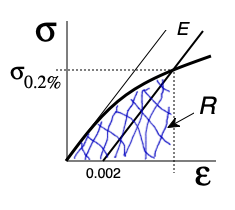Strain is determined as $\epsilon = (l - l_o)/l_o$. The 0.2% offset strain is the point where $\epsilon = 0.002$. The 0.2% offset stress is determined by using a line that has the same slope as the initial stress strain ... the initial Young's modulus. In materials that are fully elastic up to and beyond this point, the initial slope remains constant. In some cases, the stress-strain curve has a curvature to it. Polymers are an example where the modulus changes as a function of strain.
Resilience is the integrated area under the stress-strain curve up to the point of strain that you define. It is technically a term only to be used for elastic behavior. After yield, the integrated area is the toughness.
A plot below shows these concepts graphically.

The area under the curve is $R = \int \sigma\ d\epsilon$. When $\sigma = E \epsilon$ and $E$ is constant, the resilience at any $(\sigma,\epsilon)$ point along the elastic straight line becomes the area under a right triangle $R = E\epsilon^2/2 = \sigma\epsilon/2 = \sigma^2/2E$.
